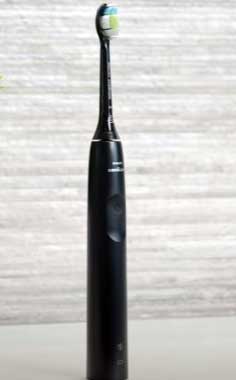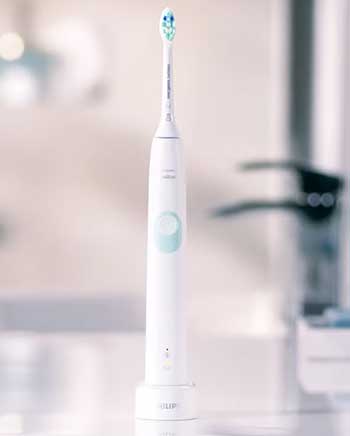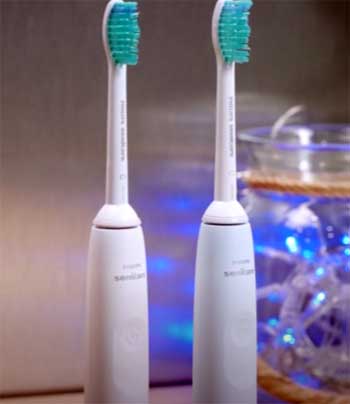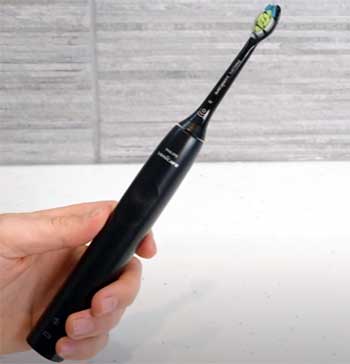I’ve been on a mission to perfect my oral hygiene, and choosing the right electric toothbrush is a big part of that journey. After testing both the Philips Sonicare 2100 and 4100, I’m here to share my experience, breaking down their features, pros, and cons to help you decide which one fits your needs.
This article compares these two popular models, focusing on their performance, design, and value, so you can make an informed choice for a healthier smile. Let’s get brushing!
A Brief Comparison Table
| Feature | Sonicare 2100 | Sonicare 4100 |
| Brush Strokes/Minute | 31,000 | 31,000 (tuned for more intense cleaning) |
| Cleaning Modes | 1 (Clean) | 2 (Clean, White) |
| Intensity Settings | 2 (High, Low) | 2 (High, Low) |
| Pressure Sensor | No | Yes (pulsing alert) |
| Brush Head | C1 SimplyClean | C2 Optimal Plaque Control |
| BrushSync Reminder | No | Yes |
| Battery Life | Up to 14 days | Up to 14 days |
| Timer & QuadPacer | Yes (2-min timer, 30-sec pacer) | Yes (2-min timer, 30-sec pacer) |
| Auto Shut-Off | No (manual stop) | Yes |
| Color Options | White, Sugar Rose, Light Blue | White, Black, Sugar Rose, Deep Pink, Azure Blue, Dark Forest |
| Retail Price (Approx.) | $35–$45 | $50–$65 |
| Warranty | 2 years | 2 years |
My Journey With Electric Toothbrushes
I’ve always been a bit skeptical about electric toothbrushes. Growing up, I stuck to manual brushes, thinking they did the job just fine. But after a dentist visit where I was told my plaque removal could use some work, I decided to give electric toothbrushes a shot.
The Philips Sonicare brand kept popping up in recommendations, praised for its sonic technology that promises to clean deeper than manual brushing. I narrowed my options to the Sonicare 2100 and 4100—two models that seemed to balance affordability and features.
After using both for weeks, I’m ready to share what I’ve learned.
Sonicare 2100: The Budget-Friendly Workhorse

The Sonicare 2100 is the entry-level model in Philips’ DailyClean series, designed for those who want a reliable electric toothbrush without breaking the bank. Retailing around $35–$45, it’s a solid choice for first-time electric brush users or anyone on a tight budget.
Here’s what I found after using it.
Pros of The Sonicare 2100
- Affordable Price Point: At roughly half the cost of the 4100, the 2100 is a steal. It delivers effective cleaning without the premium price tag, making it ideal for students or anyone looking to save.
- Slim and Lightweight Design: Weighing about 3.4 ounces, the 2100 feels sleek and comfortable in hand. Its matte finish and squared design make it easy to grip, even without rubberized surfaces.
- Two Intensity Settings: I appreciated the option to toggle between high and low intensity. The low setting was gentle enough for my sensitive gums, while the high setting gave a more thorough clean.
- Effective Plaque Removal: The C1 SimplyClean brush head, with its W-shaped bristles, did a great job reaching tricky spots like my back molars. I noticed less plaque buildup after a week of use.
- Long Battery Life: With up to 14 days of battery life on a single charge (based on two 2-minute brushing sessions daily), I didn’t need to recharge often. A color-changing LED indicates battery status, which was handy.
- Timer and QuadPacer: The 2-minute timer with a 30-second QuadPacer ensured I brushed evenly across all quadrants of my mouth. It’s a simple feature, but it kept me on track.
Cons of The Sonicare 2100
- No Pressure Sensor: This was my biggest gripe. Without a pressure sensor, I had to be mindful not to press too hard, especially since I tend to be an aggressive brusher. Over time, this could risk gum damage.
- Single Cleaning Mode: The 2100 only offers a “Clean” mode, which is fine for daily use but lacks the versatility of multiple modes for specific needs like whitening or gum care.
- No BrushSync Reminder: Unlike the 4100, the 2100 doesn’t alert you when it’s time to replace the brush head. I had to track this manually, which was a minor inconvenience.
- Manual Shut-Off: The 2100 doesn’t automatically power off after two minutes, so I occasionally brushed longer than needed, which could wear down the bristles faster.
- Fewer Color Options: Available in white, sugar rose, and light blue, the 2100 has fewer aesthetic choices compared to the 4100’s six color options.
My Experience With The 2100
Using the 2100 felt like a significant upgrade from manual brushing. The sonic vibrations were a bit ticklish at first, but I got used to them quickly. The brush head’s design made it easy to clean around my crowded lower teeth, and my mouth felt fresh after each use.
However, I caught myself pressing too hard a few times, wishing for a pressure sensor to guide me. The lack of auto shut-off also meant I sometimes brushed for 2.5 minutes before realizing the timer had buzzed.
Still, for the price, the 2100 delivered a solid clean.
Sonicare 4100: The Feature-Packed Contender
The Sonicare 4100, part of the ProtectiveClean series, is a step up, retailing at $50–$65. It’s designed for those who want advanced features without splurging on premium models like the DiamondClean.
After testing it, I could see why it’s a favorite among dentists and users alike.
Pros of The Sonicare 4100

- Pressure Sensor: The 4100’s standout feature is its pressure sensor, which pulses to alert you if you’re brushing too hard. This was a game-changer for me, as it helped me adjust my technique and protect my gums.
- Enhanced Motor Tuning: While both models deliver 31,000 brush strokes per minute, the 4100’s motor is tuned for a more intense cleaning action. I noticed a slightly deeper clean, especially along my gumline.
- C2 Optimal Plaque Control Brush Head: The 4100 comes with the C2 brush head, which Philips claims removes more plaque than the 2100’s C1. In my tests, my teeth felt noticeably smoother after using the 4100.
- Two Cleaning Modes: The 4100 offers “Clean” and “White” modes, giving me flexibility to focus on daily cleaning or stain removal. The White mode felt slightly more vigorous, which I liked for tackling coffee stains.
- BrushSync Technology: This feature tracks brush head usage and alerts you when it’s time for a replacement (typically every three months). It took the guesswork out of maintenance for me.
- Auto Shut-Off: The 4100 powers off automatically after two minutes, which I found convenient and energy-efficient.
- More Color Options: With six colors (white, black, sugar rose, deep pink, azure blue, dark forest), the 4100 offers more style choices, which was a fun bonus for personalizing my routine.
- Lithium-Ion Battery: Unlike some models with NiMH batteries, the 4100 uses a lithium-ion battery, which I found charged faster and held its charge reliably for two weeks.
Cons of The Sonicare 4100
- Higher Price: At $50–$65, the 4100 is pricier than the 2100. While the extra features justify the cost for some, budget-conscious buyers might hesitate.
- Expensive Brush Heads: The C2 brush heads cost about $7 each, compared to $6 for the 2100’s C1 heads. Over three years, this adds up, especially if you opt for BrushSync-compatible heads.
- No Travel Case: Neither model includes a travel case, but I felt the 4100’s higher price warranted one, especially for frequent travelers like me.
- USB Charger Limitations: Both models use a USB charger without a standard two-prong adapter, which was inconvenient when I didn’t have a USB port handy. Philips offers free adapters upon request, but it’s an extra step.
- Slightly Louder: The 4100’s motor tuning makes it marginally louder than the 2100. It wasn’t disruptive, but I noticed it in quiet settings.
My Experience With The 4100
The 4100 felt like a premium upgrade. The pressure sensor was a revelation—I didn’t realize how often I pressed too hard until the pulsing alert kicked in. The C2 brush head made my teeth feel polished, and the White mode was great for tackling stains from my morning coffee.
The auto shut-off was a small but appreciated touch, ensuring I didn’t overbrush. The only downside was the price, which felt steep compared to the 2100, but the added features made it worth considering.
Key Differences Between Sonicare 2100 And 4100 Toothbrush
Let’s break down the main differences that shaped my experience with these toothbrushes.
- Cleaning Performance

Both models use sonic technology with 31,000 brush strokes per minute, but the 4100’s motor is tuned for a more intense clean.
Philips claims the 4100 removes up to 7 times more plaque than a manual brush, compared to 3–5 times for the 2100.
In my tests, the 4100 left my teeth feeling slightly smoother, likely due to the C2 brush head and enhanced motor.
However, the 2100 still outperformed my old manual brush significantly.
- Brush Heads
The 2100’s C1 SimplyClean brush head is effective for basic cleaning, with a W-shaped design that cups teeth well. The 4100’s C2 Optimal Plaque Control head is denser and designed for superior plaque removal.
I noticed the C2 head reached tighter spaces more effectively, but both heads are compatible with all Sonicare brushes, giving you flexibility to switch.
- Pressure Sensor
The 4100’s pressure sensor was a standout feature. It pulses audibly when you apply too much pressure, helping you avoid gum damage. The 2100 lacks this, which was a drawback for me since I tend to brush aggressively.
If you have sensitive gums or a heavy hand, the 4100 is the better choice.
- Cleaning Modes and Intensity
The 2100 has one cleaning mode (Clean) with two intensity settings, which was sufficient for basic needs.
The 4100 adds a White mode, which I found useful for stain removal. Both offer high and low intensity settings, but the 4100’s high setting felt more powerful due to its motor tuning.
- Battery and Charging
Both models offer up to 14 days of battery life, which I confirmed through daily use. The 2100 uses a NiMH battery, requiring a full discharge before recharging, while the 4100’s lithium-ion battery can be topped up daily.
Both use a USB charger, which was convenient at home but tricky when traveling without a USB port.
- Design and Ergonomics
Both brushes have slim, matte-finished handles that feel premium and are easy to clean. The 2100 is slightly lighter, but the 4100’s additional color options added a touch of personality.
Neither felt slippery, even without rubber grips.
- Additional Features
The 4100’s BrushSync technology and auto shut-off were nice touches that the 2100 lacks. The BrushSync reminder ensured I replaced my brush head on time, while the auto shut-off saved battery life.
The 2100’s simplicity, however, made it easier to use for those who prefer a no-fuss approach.
- Cost and Value Analysis

The 2100’s lower price ($35–$45) makes it a budget-friendly option, with a three-year ownership cost of about $101–$118, including replacement heads.
The 4100, at $50–$65, has a higher upfront cost, and its C2 heads add about $11 more over three years due to their $7 price tag.
For me, the 4100’s pressure sensor and enhanced cleaning justified the extra cost, especially if you value gum health.
However, the 2100 offers excellent value for basic cleaning needs.
Who Should Choose The Sonicare 2100?
The 2100 is perfect for:
- Budget-conscious buyers looking for an effective electric toothbrush.
- First-time electric brush users who want simplicity.
- Those who don’t need advanced features like pressure sensors or multiple modes.
- People who prefer a lightweight, straightforward design.
If you’re careful about brushing pressure and don’t mind tracking brush head replacements manually, the 2100 delivers a great clean at a lower price.
Who Should Choose The Sonicare 4100?
The 4100 suits:
- Users with sensitive gums or a tendency to brush too hard, thanks to the pressure sensor.
- Those who want more cleaning flexibility with two modes (Clean and White).
- People who value convenience features like BrushSync and auto shut-off.
- Anyone willing to spend more for a slightly deeper clean and premium feel.
If you’re upgrading from a manual brush or a basic model like the 1100, the 4100’s features make it a worthwhile investment.
Which One Wins?

After weeks of testing, I lean toward the Sonicare 4100.
The pressure sensor was a game-changer for my brushing habits, and the C2 brush head and White mode gave my teeth a polished feel.
The 2100 is a fantastic budget option, delivering impressive cleaning for the price, but the lack of a pressure sensor and single mode felt limiting.
If your budget allows, the 4100’s extra features make it worth the investment for a healthier smile.
But if you’re watching your wallet, the 2100 still gets the job done admirably.
Frequently Asked Questions (FAQ)
The Sonicare 4100 has a pressure sensor, two cleaning modes (Clean and White), a C2 Optimal Plaque Control brush head, BrushSync replacement reminders, and auto shut-off. The 2100 has one cleaning mode, a C1 SimplyClean brush head, no pressure sensor, and requires manual shut-off.
No, the Sonicare 2100 does not have a pressure sensor, which means you need to monitor your brushing pressure manually to avoid gum damage.
Yes, the 4100 is worth it if you value features like a pressure sensor, two cleaning modes, and enhanced plaque removal. It’s a great mid-range option for better oral health.
The 1100 has one intensity setting and a SimplyClean or S Sensitive brush head, while the 2100 offers two intensity settings and a C1 ProResults brush head. The 2100 is often pricier but provides more flexibility.
Conclusion: Your Smile, Your Choice
You’re now armed with the details to choose between the Sonicare 2100 and 4100. If you’re after an affordable, no-nonsense toothbrush that cleans well, the 2100 is your go-to. But if you want a smarter, more feature-rich option to protect your gums and tackle stains, the 4100 is worth the extra bucks.
Whichever you pick, you’re stepping up your oral hygiene game with Philips’ sonic technology. So, grab the one that fits your needs and start brushing toward a brighter smile!
